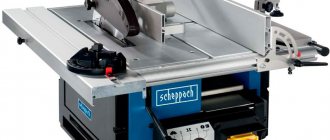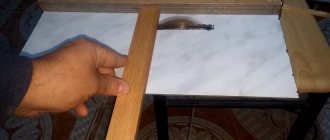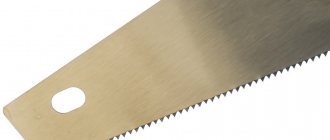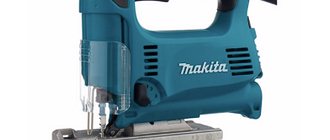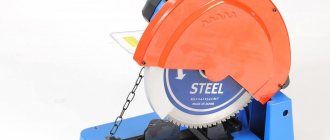A circular saw is a hand-held tool for cutting workpieces from a wide range of materials: wood, plastic and even metal. The tool is indispensable on a personal plot where a country house is being built. In an apartment, a saw will be necessary during renovations: it can be used to cut plywood, laminate, door panels, and plastic panels.
The design of a circular saw and the principle of its operation
At first glance, the device of a circular saw is as simple as possible - a powerful motor, on the shaft of which a cutting metal disc is mounted.
In the case of stationary tools, the engine can be located separately and transmit force to the working shaft with a belt through a system of pulleys, but hand tools, of which the absolute majority among household ones, are made in one housing. Adding to the complexity of the device is the need to use high-quality materials, strict adherence to the alignment of parts, plus maintaining serious safety measures. The saw blade rotates at high speeds, so neglecting any of the above points will, at best, lead to damage to the tool.
As a result, an impressive number of mechanical-electronic protective and blocking devices are added to the engine and cutting wheel, the purpose of which is to instantly stop and de-energize the tool if something goes wrong.
The principle of operation of a circular saw is clear from its design - a rotating disk with teeth cuts a board along which the tool itself is pulled. In the case of a stationary saw, everything happens the other way around - the board is pulled through a circle fixed to the frame and divided into two parts.
There is one important note about the use of a circular saw - it is not suitable for figure cutting and is intended to cut boards and other materials only in a straight line. There are models with additional graduation of the leading sole, which allows you to set the blade not strictly perpendicular to the surface being sawed, but at a certain angle, but at the same time the saw is also driven strictly in a straight line.
1. Upper main protective casing.2. Power button.3. Power lock button.4. Laser switch activation button.
5. Support handle.6. Housing with engine.7. Laser pointer.8. Adjusting the cutting angle.
9. Saw blade.10. Lower loaded casing.11. Support sole.
Most circular saws have a similar design, the difference being additional elements that expand the functions of the tool or increase the safety of working with it.
The main elements included in the design of the saw:
- Body with one or two handles;
- Protective cover for saw blade;
- Platform for holding the disc in the desired position;
- Riving knife for freeing a disk stuck in wood;
- An electric motor on the shaft of which a disk is attached using bolts.
The peculiarity of the saw is that it can be used to cut material only in a straight line (transversely or longitudinally), without the possibility of arc cutting.
The principle of operation is to transmit torque from the motor shaft to a sawing disk, which, rotating at high speed around an axis, cuts wood or other material.
Depending on the cutting depth, the tool is divided into saws:
- Small – 40-46 mm;
- Medium – 50-55 mm;
- Large – 65-70 mm;
- Professional – 65-140 mm.
The circular saw is a dangerous tool and requires careful handling and compliance with safety regulations. To prevent injuries and cuts, you must follow a number of simple rules:
- Before sawing wood, you need to make sure that there are no metal nails or screws in the workpiece.
- Inspection and repair of the tool is carried out only when it is completely disconnected from the network.
- It is not allowed to clean the saw from dust by hand. Only with a special brush.
- It is advisable to wear safety glasses when working.
- You need to work slowly, carefully and carefully.
- If you need to support the workpiece, the fingers of the hand holding the part should be parallel to the cutting line.
A circular saw is a very serious tool. You have to work on it responsibly, carefully and accurately.
The structure of a circular saw
Last but not least, the popularity of the circular hand saw is due to the simplicity of this tool. The circular electric hand saw consists of the following elements:
- saw blade;
- electric motor;
- housings with a handle or two;
- a protective casing, the function of which is to cover the disk from above and below;
- a holding platform necessary to position the disc;
- a riving knife, which is necessary to prevent the disc from getting stuck in the wood during work.
The saw blade is secured to the electric motor shaft with several bolts. Accordingly, replacing it will not take much time.
A circular saw. Concept
A circular saw is a special electric tool that allows you to quickly and smoothly cut wood products, plywood, laminate and various boards.
There are household and professional models. The former can function with pauses. Their engine needs breaks of 15-20 minutes. They cannot withstand significant loads.
The latter have more powerful engines. They can work intensively for a very long time. Therefore, they are usually used in production.
For personal use, household modifications are used. And keeping professional versions is unprofitable.
The level of work and its types are determined by the frame of this tool.
Basic tool parameters
Circular devices can be divided by power. The more powerful the electric motor, the higher the stability and quality of the cut. As power increases, the weight and size of the saw increases. The cost of equipment also depends on this indicator. Therefore, when choosing a tool, you first need to determine the range of tasks that it should solve. Today saws are divided into:
- Household ones, which are used for occasional simple work around the house or on a summer cottage. Characterized by motor power up to 800 W.
- Universal. They live up to their name by being able to perform a wide range of tasks. Universal models can perform complex work, and they are used even in industry. The motor has a power of 800 to 1200 W.
- Professional equipment. They have a motor with a power of 1200 W. This is a very large tool and requires work skills and a certain amount of skill. It is used in serious industries and is practically not used in everyday life.
Each type has the following characteristics:
Rotation speed of the cutting blade. The value of this value determines what density of material the cutting disc can cut.- Thermal resistance of the housing. The housing can be made of plastic, metal or a mixture of both.
- Depth of cut. The standard value for a home saw is sixty millimeters. Professional models can cut workpieces up to 140 mm deep.
- Availability of battery.
- Ability to adjust the angle of inclination.
How to choose a saw
When choosing a circular saw, you need to focus on important technical parameters:
- Power. The depth of cut and the number of revolutions depend on it. For light household work, up to 1200 W is enough, like BOSCH PKS 40 2015, AEG KS 55-2. For serious volume, it is desirable from 1600 W, for example, STANLEY STSC1618, ZUBR ZPD-2000. Professionals advise purchasing a tool with a reserve of power characteristics.
- Rotational speed. Circular hand saws have 3,000 to 6,000 rpm. The average value is 5500 rpm, like the DeWALT DWE560. This parameter affects the density of the material being cut and how clean the cutting process will be.
- Disc diameter. The depth of the cut is directly dependent on it. For domestic purposes it is 27-45 mm, while the diameter of the disk is 89-185 mm. These include BOSCH PKS 40 2015, RYOBI RWSL1801M. For semi-professional models, such as AEG KS 55-2, the cutting depth is 50-55 mm, the disc diameter is 160-170 mm. For professional units this figure is 60-100 mm and 160-235 mm, respectively. These parameters are for Makita HS7601, Hammer CRP 1500 D, ZUBR ZPD-2000.
We suggest you read: How to clean white plaque from brick
When deciding which is the best circular saw to buy, you need to pay attention to the presence of additional functions. It’s good if the equipment allows you to perform a soft start, there is a lock against accidental start. You need to hold the circular saw in your hand and make sure of its ergonomics. These feelings are purely individual. Some will like the Makita HS7601, others will appreciate the convenience of the BOSCH PKS 40 2015.
Professional saws are equipped with adjustable cutting angle. In order to simply cut boards, this function is not needed. But you need to pay attention to such a detail as the spindle lock. If it is not there, it will be more difficult to change saw blades; you will have to use two keys. Depending on the operating conditions, such characteristics as autonomous operation from a battery or mains are important.
What is the best circular saw? It is very difficult to answer this question; it all depends on the amount of work, the materials used for processing, as well as individual preferences. In the process of choosing a high-quality circular saw, you will have to study in detail a large number of characteristics. Most circular saws have a seven-inch saw blade, suitable for a wide range of jobs. Models are sold that have a larger diameter saw blade, but they are not needed for cutting beams and beams.
In addition, an important characteristic is the degree of inclination with which the saw operates. Almost any circular saw can be set to a bevel angle of 45, but there are also models with a bevel angle of up to 55 degrees and even more. Cutting at an acute angle is a very convenient function of a circular saw.
The fundamental indicator when choosing a saw is the depth of cut. This indicator directly depends on the diameter of the saw blade. But at the same time, the larger the saw blade, the higher the power of the saw should be, which in turn affects the power of the motor and, accordingly, the weight of the tool.
You can find saws on sale that are equipped with laser guides, which are very helpful in the process of sawing boards or making long cuts, for example, on multi-layer plywood. Some models also have LED backlighting, making it easier to work in dimly lit areas.
Some circular saws have an interesting plunge function, which makes it possible to cut workpieces not only from the end of the board, but from anywhere on it. Craftsmen are also interested in the chip removal system. This system saves significant time. With this saw you don't need to clean up your workshop. In addition, not everyone knows that wood dust is very harmful to health. Therefore, it is better to purchase a model with such a system.
Before purchasing, you need to think about what material you will process with this tool. Hard types of timber, such as oak, can only be sawed with a very powerful saw. The higher the power, the easier it is to work.
Almost all saws in the starting configuration have a small amount of equipment. Most often, only guides are present. It’s rare to find models that come with a safety clutch that prevents the saw from kicking back if the blade jams.
Measure seven times - cut once!
Following the wise saying, place the saw on the intended cut and see if everything matches?
The next step is to make an introductory cut of 3-5 mm.
Make sure that the disk begins to spin before it contacts the sheet of plywood. If you turn on the saw while the saw blade is in contact with the sheet, it will simply break it.
Check that the cut you made matches the markings.
About the elements of the frame
The attachments for a circular saw are different. The main one is the bed. If the power of the saw is insignificant (no more than 1.2 kW), such a frame is not difficult to build yourself. Its length is affected by the length of the material going for cutting.
An electric drill “Bosch” is suitable for the drive; its parameter is 0.85 kW. It is mounted under the stove using a special bracket.
The accuracy and evenness of the cut is better when the workpiece rests entirely on the table surface. And if the table has too large parameters, it will fill the entire work area. Here you need an average value. The height is selected according to your height to make it more convenient to work.
Features of a manual circular saw
An electric hand-held circular saw is specialized for sawing wood, both along and across the grain. Because of this, there is another name for it: “parquet”. Despite this specialization, by changing the discs, versatility in sawing other materials is easily achieved.
Any tool should be easy to use. A hand-held circular saw meets this requirement due to its size, the presence of a handle or two, and a sole that allows you to transfer the weight to the support.
From a safety point of view, the most expensive models look the most advantageous, as they feature a lock against unwanted start-up, a soft start system and a slip clutch, which is useful when the disk gets jammed.
The optimal power range of a circular saw for wood lies in the range from 500 to 1200 W: this is sufficient for all household needs, including not too frequent work on metal.
You can focus on such qualities as rotation speed and depth of cut only taking into account the purposes and prevailing conditions of use of the electric saw.
Compared to similar saws of other types, the “circular” saw is more productive, but at the same time heavier. And since productivity depends not only on the tool, but also on banal human endurance, then when you are supposed to work alone, you shouldn’t chase too much productivity indicators at the expense of the lightness of the saw. Both numbers are indicated in the instrument’s passport: you need to familiarize yourself with them before, for example, buying a circular saw for wood.
In this regard, a balanced attitude and recommendations from friends are required: with different materials, the same model of circular saw can behave differently.
In addition, despite the versatility of the sawing tool, manufacturers of good models of saws often warn about the undesirability of working with materials such as sheets of metal tiles. Such precautions are not unfounded: the tool quickly becomes unusable and susceptible to corrosion due to sparks flying during sawing, which increase its vulnerability to atmospheric moisture.
We suggest you read: Why does a brick oven smoke? Possible reasons
There are special devices for securing a hand-held circular saw to a workbench.
Stationary circular saws are practically not used for household needs, since they are quite difficult to operate, and the professional version is very expensive and structurally complex. Therefore, in most cases, hand saws are used.
There are special devices on sale that can be used to mount a hand saw on a work table in an upside-down position. This allows you to get a stationary mini-machine, which will be very convenient to work with. This mount is not suitable for all models of saws. There are also models available, the equipment of which includes their installation on the frame. These features of circular saws should be taken into account when purchasing them.
Nickel-cadmium batteries
Circular saw Ryobi, 1150W, 3000552(EWS1150RS)
- nickel-cadmium have a combination of high capacity and low cost.
- service life is about 10 years;
- the battery is not afraid of negative temperatures;
- withstands about 1000 charge and discharge cycles;
- can be stored for a long time in a discharged state;
- can be completely discharged.
The chemicals inside the battery are harmful to the environment, so certain conditions must be observed when disposing of them. Nickel-cadmium batteries have a “memory effect”.
Making a table
When you need to assemble accessories for a circular saw with your own hands, the first step is to create a frame. It consists of a base and a table top.
The design of the second element is influenced by the structure of the working disk fastener.
The process of creating a key fixture for a circular saw takes place in several stages. They are outlined below:
- A functional table (table top) is created from a plywood sheet. Work proceeds according to the selected parameters. Markings are made on the sheet using a pencil along a ruler. The sheet is cut with a jigsaw. The edges are processed with a router. The created workpiece is polished.
- Marks for the saw are indicated on the bottom plane of the tabletop. The completed workpiece is turned over. A saw without a blade is placed on the intended area. The parameters of the sole are indicated.
- Using a router, an 8-10 mm opening is created in this material according to the designations of the landing area.
- Trying on a saw. If necessary, the parameters are adjusted. Then the areas of its fasteners and the slot for its disk are designated. If the material will be cut at different angles, this must be taken into account when marking the slot. She will receive a section in the shape of a trapezoid. The top will rush down.
- The pencil marks the stiffening ribs. The legs will join them later.
- Work on the stiffeners. To create them, boards 5 x 10 cm are used. They are placed around the perimeter at a distance of 7-10 cm from the extreme side of the table. The board is applied to the tabletop. Circled on both sides. Its main line is marked along the ruler. The positions of the screws are marked on it. They are as follows: 5 cm - from the extreme side of each of the existing ribs. In this case, a distance of 15-20 cm is maintained along the entire length of the rib. Through holes are drilled according to the created markings.
- Longitudinal stiffening ribs are installed. To do this, boards are marked and sawn. They are glued to the tabletop. They are tightened with clamps.
- The side stiffeners are marked. The boards are sawn and glued as in step 7.
- The clamps are held in place. The structure is pulled using self-tapping screws through the created holes, which are pre-drilled from the outside. This way the heads of the screws will be completely sunk into the table top.
- The stiffening ribs are tightened together with two 5 cm self-tapping screws. The tightening occurs from all sides. Clamps are removed. It turns out to be a tabletop.
Lithium-ion batteries
Lithium-ion batteries have become widespread recently and have no competitors in performance characteristics:
- complete absence of “memory effect”;
- can be charged at any discharge level;
- at any level of discharge the voltage does not decrease;
- Can be used for up to 8 years;
- self-discharge is present but not great;
- charge quickly;
- do not pose a danger to the environment;
If the low cost and some features of lithium-ion batteries:
- sensitive to mechanical stress;
- at low temperatures, complete loss of charge is possible;
- the cost is quite high.
Lithium-ion batteries are widely used in the manufacture of all kinds of gadgets. Their advantageous features are large capacity and short charging time. Manufacturing companies have modernized the charging process, which has increased the possible number of charge-discharge cycles.
The parameters of power sources are always indicated in the instructions for use and on the battery itself. The batteries indicate the voltage (up to 54 Volts) and the current that the battery can supply to the consumer for one hour (Ampere hour).
Characteristics of a circular saw
Comparison table of the most used circular saws.
- Power. As with all construction tools, the main characteristic of circular saws is power, since it is the key to the smooth operation of the device. Circular saws with higher power are able to cut material faster, and its density can be higher. On the other hand, low-power saws have less weight, which makes operating such a device much easier. For example, a 2 kW circular saw will weigh 7 kg, and a 1.2 kW tool will weigh 3.5-4 kg. When choosing power, you should also consider the size of the blade that will be used to cut the material. The smaller the disk diameter, the less power you can choose. Circular saws are:
- low power (up to 0.8 kW);
- average power (0.8-1.2 kW);
- high power (more than 1.2 kW).
- Weight. This parameter is also important. This should be especially taken into account when you are going to work with the saw for a long time and under weight. Therefore, if possible, buy a saw with light weight.
- Depth of cut. This characteristic is largely determined by the size of the disk used: the larger the disk, the larger the material it can cut. If, in order to save money, you decide to purchase a tool with a small disk diameter, then it will not be able to accurately cut a thick workpiece. Lightweight models, which are used for household needs, have a cutting depth of 40-50 mm. This size is the most popular. For professional work, for example, with a block, it is recommended to use a disk with a cutting depth of 60-70 mm.
- Speed. This parameter determines the quality and speed of sawing. The rotation speed largely depends on the diameter of the disk, since what is important is not how many revolutions per minute the disk makes, but at what speed its edge moves along the workpiece.
- Ability to work at an angle. The design of most models allows cutting at an angle of 45°, but there are saws that can also work at an angle of 60°. You can only change the cutting angle on one side, because the engine is located on the other. There are models on the construction market in which this parameter can be adjusted on both sides.
- Autonomous work. Cordless saws allow you to work without a stationary power supply. Such models are characterized by lower productivity. Before buying a circular saw with a battery, you need to think carefully, because the battery life of the device lasts for 30-60 minutes, and charging the battery can last about 5 hours.
- Laser pointer. It is a very useful device with which you can make a more accurate cut.
- Accidental start blocking. In order to ensure safety from the possibility of accidental activation of the device, there is a button on its body that prevents accidental starting of the saw. The absence of such a mechanism can lead to injuries during work.
- The soft start function extends the life of the tool and makes work safer.
- Immersion function. Some models that have this function allow you to start cutting not from the beginning, but from the desired place. This can be useful when you need to cut a hole, for example in ceramic tiles.
- Convenient disk replacement. When working with a circular saw, sometimes you need to change one disc for another. Therefore, the convenience of replacing them is very important.
We suggest you read: How to use a circular saw on wood
These functions greatly facilitate working with the tool, making it more comfortable and safe. Therefore, when choosing a circular saw, you should take into account all its characteristics and take into account all the little things, since not only the quality and efficiency of the work, but also your safety will depend on your choice.
Electric circular saws for wood have a number of unique qualities that set them apart from other hand-held sawing tools. So, in particular, you can change the depth and angle of the cut directly during operation. Particularly good in this regard are submersible models, which allow you to make isolated cuts of specified sizes.
It should be taken into account that the quality and accuracy of sawing will depend on the number of teeth and the sharpening angle of the disc. With an increase in the number of teeth on the electric saw blade, the quality of the cut increases, but at the same time the productivity inevitably decreases. Next, you need to pay attention to the power of the motor and the lightness of the tool, as well as compliance with safety regulations: the strength of the fastenings, including the protective casing, the integrity of the electrical insulation, etc.
Disc Features
For hand-held circular electric saws, discs are produced with or without hard alloy soldering. The absence of soldering allows for accurate cuts in soft wood.
The discs are complemented with carbide tipped for working with very hard wood, as well as low-viscosity plastic, metal, and nails. You should not expect a clean cut from such a disc, but the performance is higher.
Among the characteristics of a hand-held circular saw, one important factor can be identified: the sharpening angle of the circular teeth. It is not difficult to distinguish them: the teeth curved along the disk rotation form a positive angle, and against them - a negative angle.
A positive sharpening angle of the teeth is required for the best cutting of wood, including boards with nails, and plastic. Discs with a negative sharpening angle are usually used for cutting sheet metal, etc.
However, a disk with a negative sharpening angle of the teeth can also be used to cut wood if the requirements for the quality of the cut are not high: in this case, the wood fibers are torn, and the material looks more like it has been gnawed than sawn through.
Additional functions
Some models have additional features. These seemingly little things help you choose a circular hand saw. List of possible additions:
- Smooth start. Its presence reduces the number of “twitches” of the tool, improving the quality of the cut and increasing the life of the motor.
- Collection of sawdust. Some models have a hose for connecting a vacuum cleaner.
- Laser tag. Visually shows the future cutting line on the product. When using it, there is no need for a guide bar.
- Autonomous chip removal system. Eliminates the need for an external vacuum cleaner. Suitable for small production volumes.
- Possibility of start blocking. To start the engine in this case, you need to press two buttons. This solution increases the safety of the device and prevents accidental cutting through the workpiece.
Creating legs
Assembling a full-fledged device for a circular saw is not limited to these stages.
For the legs you will need a board 5 x 10 cm. Their height is 1-1.2 m.
The board is cut along the longitudinal vector. In this case, a slight angle is maintained on one side.
The legs are fitted to the tabletop. During installation they should be slightly apart.
They are attached outside the stiffeners. Fastening method: bolted. To increase their stability, you will need ties. They require a 5 x 5 cm block.
The hand saw is placed in the previously created groove from the lower area of the tabletop. The sole is fixed with bolts. The disc is placed in the slot.
The table is varnished in 3-4 layers. This is a measure against moisture.
Question about long cuts
Creating an attachment for a hand-held circular saw that will help make long cuts is important for many home craftsmen. It greatly simplifies the work.
It's easy to do. Fiberboard is taken. A sample is cut from this material. It is identical to the distance from the outer side of the tool base to the outermost part of the disk from the inside.
When cutting, you need to rely on the length of the tool base.
The edge of the sample is aligned with the cut mark on the workpiece. A straight piece is applied to the second side. This is the guide. It is fixed with a clamp.
On the second marking, this operation is duplicated, but on the opposite side of the workpiece.
To create a template, it is optimal to use a router or jigsaw.
Solving the problem with chips
If the disc chips while working, you cannot do without the following device for a hand-held circular saw, assembled with your own hands.
Technology:
- The hardboard element is cut out. Its density is 6 mm. When cutting, you need to focus on the width of the tool base.
- The disk is retracted. The protective cover rises. The result of step 1 is attached to the base with double-sided tape. After this, the saw starts. The disc fits smoothly into the hardboard. This results in zero gap in operation.
Sawing should be done with little impact on the created base.
Tags: drink, principle, work, circular
« Previous entry

